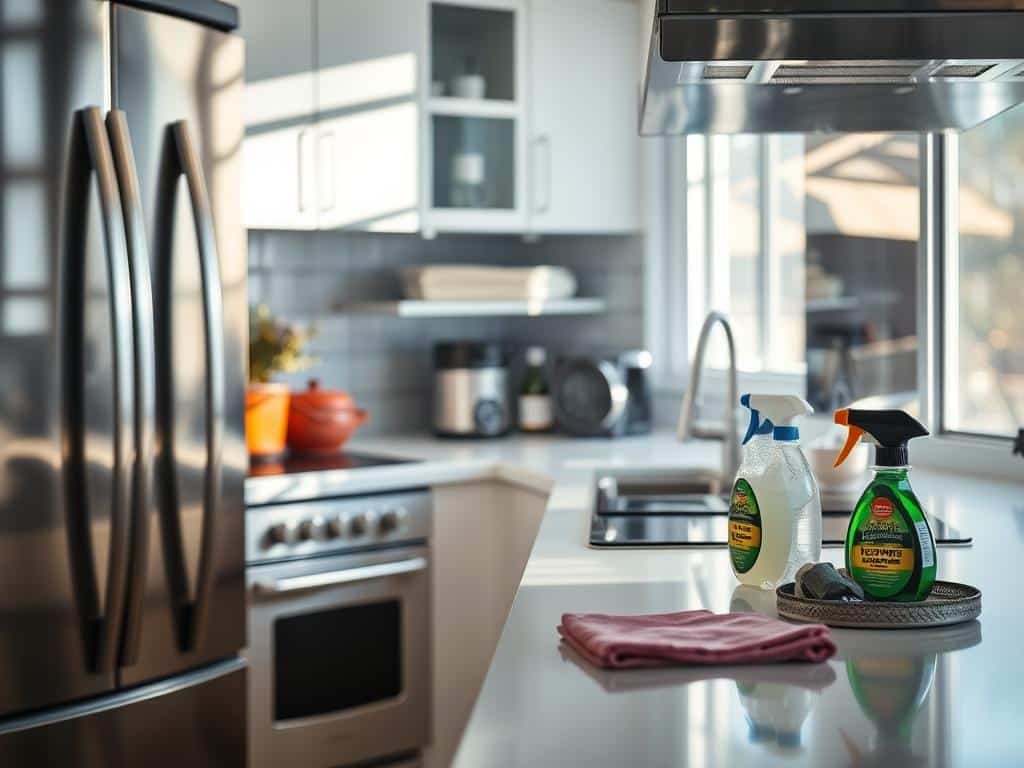
Maintaining your kitchen appliances not only makes them look good but also helps them last longer and work better. If you’re looking for tips on cleaning refrigerators, microwaves, or dishwashers, it’s important to keep each device in great condition. Making sure your stovetop and oven are clean, along with knowing how to clean your coffee maker and toaster, keeps your kitchen spotless and working well.
Start by cleaning up spills right away with a mix of vinegar and water. For tougher jobs, use the right kind of cleaners. This guide will show you how to keep all your kitchen appliances in perfect shape. From getting rid of smells in your fridge to using dishwasher-safe containers for easy cleaning, we’ve got everything you need. Cleaning often, especially stainless steel appliances, will keep your kitchen looking and smelling fresh.
If you need more detailed advice, check out our complete guide on how to clean kitchen appliances effectively. Our guide provides detailed tips for both daily and deep cleaning. Following our advice will ensure your appliances work well and last longer.
Clean Your Refrigerator for Freshness and Efficiency
Keeping your fridge clean is key to its efficiency and keeping your food fresh. Simple maintenance routines and occasional deep cleans will keep it looking and smelling great.
Routine Maintenance Tips
Start with regular upkeep for your refrigerator. Wipe the door handle daily and clean surfaces with a safe cleaner. Also, organize your fridge to avoid clutter. It’s important to throw away old food every week.
Be careful when cleaning glass parts. Let them cool down first to avoid cracks. If you have a stainless steel fridge, use a special cleaner. Plastic fridges can be cleaned with soapy water. For tips on keeping your kitchen clean, read this guide on daily cleaning.
Deep Cleaning Steps
Deep clean your fridge every three to four months. Empty it and clean all surfaces with baking soda and warm water. Don’t forget to clean under drawers and door seals. If you have a water dispenser, clean the lines twice a year.
For tough stains, mix water and white vinegar. Dry all surfaces well before putting everything back. Check here for more tips on cleaning your fridge cleaning and sanitizing guide.
Eliminating Odors
Getting rid of odors is important. Regularly throw out smelly or spoiled food. An open box of baking soda can neutralize odors. Clean the tray under your water dispenser with vinegar to avoid stains.
Keep the seal around the door clean to ensure it closes tightly. Use warm, soapy water or a bleach cleaner for mold. These steps will help keep your fridge fresh and efficient.
Keep Your Dishwasher Spick and Span
Keeping your dishwasher clean is key to making it last longer and work better. Regular cleanings can stop bad smells and help your dishwasher run better. It’s smart to clean your dishwasher often. This saves time, energy, and makes your appliance work more efficiently.
Everyday Cleaning
To keep your dishwasher working well, begin with easy daily cleaning steps. Clean the door edges and the gasket with a damp cloth to get rid of food bits or dirt. It’s best not to run it unless it’s full. Running a half-full dishwasher wastes water and energy, like washing just a few socks. Make sure to scrape off only big food pieces from dishes to keep the filter clean.
- Remove trapped food particles daily.
- Wipe down the door seal regularly to prevent mold build-up.
- Properly load silverware with handles down (except knives) and facing the dirty side of dishes towards the center.
Monthly Deep Clean
Doing a deep clean every month is important. Start by putting a cup of distilled white vinegar in a dishwasher-safe bowl on the top rack. Then run a hot water cycle. This helps sanitize and gets rid of soap scum. It also helps remove hard water stains. Next, to clean the inside further, spread baking soda on the bottom and run a short, hot cycle. This helps get rid of smells.
- Run the dishwasher empty with a cup of vinegar on the top rack.
- After the cycle, manually clean the spray arms, door tops, and sides.
- Spray arm cleaning is essential for removing blockages, ensuring even water distribution.
- For tough stains, consider using a steam cleaner.
Lastly, make sure the dishwasher’s outside is clean. It should be free of fingerprints and smudges. Use a stainless steel cleaner and a microfiber cloth for this. Remember, taking care of your dishwasher means cleaning both inside and outside for the best results.
| Task | Frequency |
|---|---|
| Wipe Door Edges | Daily |
| Clean Spray Arms | Monthly |
| Run Vinegar Cycle | Monthly |
| Remove Hard Water Deposits | Monthly |
| Clean Filter | Every 3-6 Months |
How to Clean Kitchen Appliances: Your Stovetop and Oven
Keeping your stove and oven clean is key in any kitchen. It improves the look and helps with better cooking. It also makes your appliances last longer. Here are tips for keeping them spotless.
Stovetop Cleaning Tips
It’s important to clean stovetops right after you use them. Once it’s cool, wipe it down with a damp cloth and cleaner. For tough stains, a strong cleaner and a soft scraper work well.
Try making a cleaner with cleaning with baking soda and water. It’s good at getting rid of grease and dirt without strong chemicals.
Oven Cleaning Methods
Cleaning your oven can be easy and effective. Warm it up to 225 degrees Fahrenheit, then put in water and soap. Use a sponge on the inside to scrub away grease and smoke stains. For a greener choice, cleaning with baking soda and vinegar works well.
If you have a self-cleaning oven, it’s still important to clean some areas by hand. The self-clean doesn’t get everywhere.

Maintaining Your Appliances
Regular upkeep is crucial for keeping your stovetop and oven working well. Cleaning often prevents hard-to-remove stains. This helps your appliances run better and look nice.
Also, try to use mild cleaners and make sure your kitchen is well-ventilated when cleaning.
Best Practices for Cleaning Your Microwave
Keeping your microwave clean is key for it to work well and stay hygienic. You should clean it regularly and do a thorough cleaning now and then. This makes sure it runs at its best.
Quick Daily Cleanup
To keep it up every day, just wiping it down does the trick. Use a damp cloth to wipe inside after using it. If you mix a bit of liquid dish soap in water, that damp cloth can fight off spills. Doing this simple step daily stops build-ups and makes deep cleaning easier.
Remember to regularly clean the glass turntable too. You can wash it in the dishwasher or by hand with soapy water. Keeping this part clean helps your microwave work well and stay nice looking.
Deep Cleaning Process
Deep cleaning isn’t needed every day, but it’s really important. To get rid of stuck food, steam clean it. Just heat a bowl of water in the microwave until it boils, usually 2 to 5 minutes. The steam will loosen everything, so wiping it off is easy.
A mix of water and vinegar makes a great microwave cleaner. Heat it up until it boils. Vinegar’s acid fights grease and kills germs, leaving your microwave clean and smelling fresh.
Also, clean your microwave’s grease filters monthly, if it has them. Cleaning your microwave weekly is a smart habit. It prevents spills from getting hard and keeps your cooking space sanitary.
| Cleaning Method | Tool/Ingredients | Frequency |
|---|---|---|
| Quick Daily Cleanup | Damp cloth, dish soap solution | Daily |
| Steam Cleaning Method | Microwave-safe bowl, water | Monthly |
| Vinegar Solution for Microwaves | Water, vinegar | Monthly |
| Cleaning Grease Filters | Manual wash | Monthly |
Maintain Small Kitchen Appliances
Keeping your small kitchen appliances in top shape is key. This includes cleaning food processors, coffee makers, and toasters regularly. A steady cleaning routine ensures they function well and last longer.
Cleaning Blenders and Food Processors
Blenders and food processors are used often. They need to be cleaned regularly to stop contamination and keep them running smoothly. After using them, quickly rinse all parts that come off with warm soapy water.
For a deep clean, fill the blender or food processor with warm soapy water. Run it for a cleaning cycle, then rinse and dry. This gets rid of food stuck on the inside.
Tips for Coffee Makers and Toasters
You should clean your coffee maker’s removable parts daily with warm soapy water. Also, descale it with vinegar and water mix now and then to clear mineral buildup. For toasters, unplug and shake out the crumbs.
Wipe the outside with a gentle soap. Do a detailed cleaning weekly, on the inside and outside. This makes sure your small appliances are cared for properly.
Conclusion
Cleaning your kitchen appliances regularly is key to their longevity and efficiency. This includes everything from refrigerators to blenders. A clean appliance works better and creates a healthier home. Using cleaning solutions like water and vinegar can help with quick cleanups. Special products are there for taking care of stainless steel.
By keeping up with appliance cleaning, you stop cross-contamination and ensure food is safe. Dirty appliances use more energy, leading to higher bills. So, taking care of your appliances means they will last longer and work better. They also make your kitchen look nicer, making cooking more enjoyable.
Using natural cleaning products is good for both your health and the planet. Sometimes, getting a professional to clean your appliances can make a big difference. Keeping up with cleaning, like wiping surfaces every week or deep-cleaning filters regularly, is essential. This ensures your appliances are in great shape for all your cooking adventures. It makes your kitchen experience better overall.



